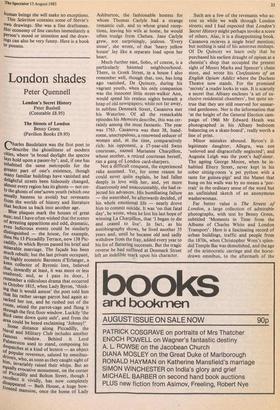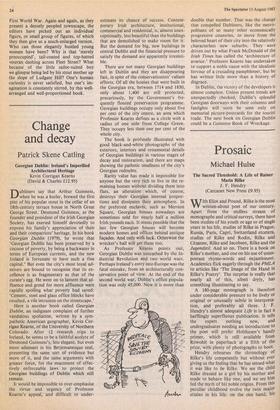gm.
London shades
Peter Quennell
London's Secret History Peter Bushell (Constable £8.95) The Streets of London Benny Green (Pavilion Books £9.95)
Charles Baudelaire was the first poet to describe the ghostliness of modern cities, where 'in broad daylight the spectre lays hold upon a passer-by'; and, if one has inhabited the same metropolis for the greater part of one's existence, though Many familiar buildings have vanished and delightful streets been hideously changed, almost every region has its ghosts — not on- ly the ghosts of one'sown youth (which one usually hastens to avoid) but revenants from the worlds of history and literature that beckon us back into another age. Blue plaques mark the houses of great men; and I have often wished that the scenes of arresting apparitions and odd, dramatic, even ludicrous events could be similarly distinguished — the house, for example, then No 13 Piccadilly Terrace, now 138 Pic- cadilly, in which Byron passed his brief and Miserable marriage. The façade has been much rebuilt; but the last private occupant, the highly eccentric Baroness d'Erlanger, a keen collector of Byronic lore, believed that, inwardly at least, it was more or less unaltered; and, as I pass its door, I remember a ridiculous drama that occurred October 1815, when Lady Byron, 'think- ing that it would amuse' the poet told him that his rather savage parrot had again at- tacked her toe, and he rushed out of the Tom, seized the parrot-cage and flung it through the first floor window. Luckily 'the Bird came down quite safe', and from the area could be heard exclaiming 'Johnny!'
Some distance along Piccadilly, the Naval and Military Club includes another
Palmerston window. Behind it Lord valmerston used to stand, composing his despatches at a kind of lectern — an object of popular reverence, saluted by omnibus- drivers, who, as soon as they caught sight of him, invariably raised their whips. But an equally evocative monument, on the corner of Piccadilly and Bolton Street, though I recollect it vividly, has now completely a,,IsaPpeared — Bath House, a huge bow- 'routed mansion, once the home of Lady
Ashburton, the fashionable hostess for whom Thomas Carlyle had a strange romantic cult, and to whose grand recep- tions, leaving his wife at home, he would often trudge from Chelsea. Jane Carlyle grew, not surprisingly, jealous. 'Every stone', she wrote, of that 'heavy yellow house' lay like a separate load upon her heart.
Much further east, Soho, of course, is a particularly haunted neighbourhood. There, in Greek Street, in a house I also remember well, though that, too, has long ago vanished, De Quincey, during his vagrant youth, when his only companion was the innocent little street-walker Ann, would spend his restless nights beneath a heap of old newspapers; while not far away, in subfuse Denmark Street, Casanova met his Waterloo. Of all the remarkable episodes his Memoirs describe, this was cer- tainly among the most fantastic. The year was 1763. Casanova was then 38, hand- some, unscrupulous, a renowned seducer of women and, at the time, comparatively rich: his opponent, a 17-year-old Swiss courtesan, named Marianne Charpillon, whose mother, a retired courtesan herself, ran a gang of London card-sharpers.
Not a difficult conquest, the experienced rake assumed. Yet, for some reason he could never quite explain, he had fallen deeply in love with her, and, yet more disastrously and unaccountably, she had re- jected his advances. His humiliating failure — the watershed, he afterwards decided, of his whole emotional life — nearly drove him to commit suicide. It was 'on that fatal day', he wrote, when he lost his last hope of winning La Charpillon, that 'I began to die and ceased to live'. In fact, as his autobiography shows, he lived another 35 years and, until he became old and sadly withdrew from the fray, added every year to his list of flattering successes. But the tragic reverse he had suffered at Denmark Street left an indelible mark upon his character. Such are a few of the revenants who ac- cost us while we walk through London streets; and I had expected that London's Secret History might perhaps invoke a score of others. Alas, it is a disappointing book. Casanova recieves a single brief mention; but nothing is said of his amorous mishaps. Of De Quincey we learn only that he purchased his earliest draught of opium at a chemist's shop that occupied the present sight of Messrs Marks and Spencer's chain store, and wrote his Confessions of an English Opium Addict where the Duchess Theatre now stands. For the promised 'secrets' a reader looks in vain. It is scarcely a secret that Albany encloses 'a set of ex- clusive residential chambers', but quite un- true that they are still reserved for unmar- ried gentlemen. Nor is the information that 'at the height of the General Election cam- paign of 1966 Mr Edward Heath was photographed in his Albany bedroom balancing on a skate-board', really worth a line of print.
Minor mistakes abound. Byron's il- legitimate daughter, Allegra, was not 'unloved and disgracefully neglected'; and Augusta Leigh was the poet's half-sister. The ageing George Moore, when he in- habited Ebury Street, never kept in his sober sitting-room 'a pet python with a taste for guinea-pigs' and the Manet that hung on his walls was by no means a 'por- trait' in the ordinary sense of the word but an unfinished sketch of an anonymous washerwoman.
Far better value is The Streets of London, a large collection of admirable photographs, with text by Benny Green, subtitled 'Moments in Time from the Albums of Charles White and London Transport'. Here is a fascinating record of urban buildings, traffic and people from the 1870s, when Christopher Wren's splen- did Temple Bar was demolished, and the age of the aristocratic carriage and the horse- drawn omnibus, to the aftermath of the First World War. Again and again, as they present a densely peopled townscape, the editors have picked out an individual figure, or small group of figures, of which they then give us a much-enlarged version. Who can those elegantly bustled young women have been? Why is that `sternly preoccupied', tail-coated and top-hatted veteran dashing across Fleet Street? What became of the little sailor-suited boy we glimpse being led by his stout mother up the slope of Ludgate Hill? One's human curiosity is never satisfied, but one's im- agination is constantly stirred, by this well- arranged and well-proportioned book.







































 Previous page
Previous page